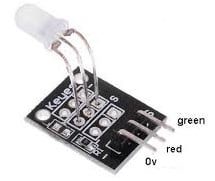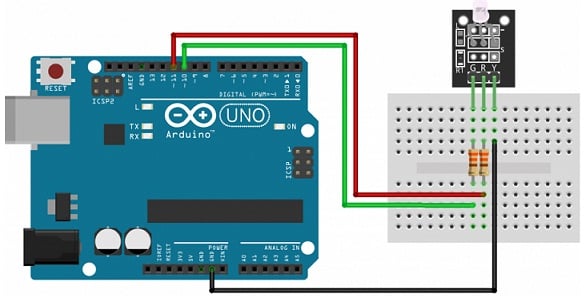Day by day LED technology is progressing by creating Bi-color LEDs. This concept emerged as a method to use various colors in a single module to design more complex visual displays. Engineers call these bi-color or dual-color LED modules because they include two different colored LEDs in a single package. Electronics projects commonly use these modules when they need visual indicators with various states and special color indicators for user interfaces and circuit boards. Thus, examples of two-color LED modules are; KY-011 LED Module, SeeedStudio Grove, SunFounder, Adafruit NeoPixel, Generic 3mm, M5Stack, etc. This article elaborates on the KY-011 LED module, pinout, features, specifications & its applications.
What is the KY-011 LED Module?
The KY-011 features a small two-color LED module that combines two different color-based LEDs in a single package like red & green. You can separately illuminate either color or generate a blended color by controlling two LEDs altogether. This can individually control each LED to switch between the two colors. You can create an intermediate yellow color by adjusting both LED’s brightness simultaneously. Engineers use these modules when they need visual feedback to display different states or status indicators through color differences.
How KY-011 LED Module Work?
A KY-011 two-color LED module works by using a single LED that includes two colors red & green with a common cathode which means both LEDs share a similar negative connection. So when a voltage supply is provided to the suitable pin, then you can selectively illumine either the green or red color LED thus it creates a two-color display effectively depending on which pin is triggered.
Both the LEDs in this module share a single cathode connection by controlling the voltage supply on every individual pin. So these modules are very useful for different projects that need visual feedback by color indication, like simple signal displays or status indicators on an electronic device.
Pin Configuration:
The KY-011 LED module pin configuration is shown below. So this module includes three pins which are discussed below.

KY-011 LED Module Pin Configuration
- Pin-1 (GND): It is a ground pin of the dual LED module.
- Pin-2 (RED): It is a red color LED signal pin of the module.
- Pin-3 (Green): It is a green color LED signal pin of an LED module.
Features & Specifications:
The features and specifications of the KY-011 LED module include the following.
- KY-011 is a two-color LED module.
- Its diameter is 5mm.
- LED type is Bi-color with a common cathode.
- The package type is diffusion.
- Input voltage supply ranges from 2.0V to 2.5V.
- The working current supply is 10mA.
- The viewing or beam angle is 150.
- Luminous intensity or MCD is 20 to 40, 40 to 80.
- The stent type is long-legged.
- Its output color is red + green.
- It is compatible with PWM.
- These are compact, efficient, and cost-effective.
- It has dual color brilliance.
- Its operating temperature ranges from -40°C to 85°C.
Equivalents & Alternatives
Equivalents to KY-011 are; NeoPixel, APA102C, WS2812B, etc. So alternative KY-011 are; AKY-029, KY-029, REES52, Ab020, etc.
KY-011 LED Module Interfacing with Arduino Uno
The KY-011 LED module interfacing with Arduino Uno is shown below. Thus, the required components to make this interfacing mainly include a KY-011, Arduino Uno board, connecting wires, and breadboard.
The connections of this interfacing follow as;

KY-011 LED Module Interfacing with Arduino Uno
- Connect Pin-9 of Arduino Uno to the LED green pin of the sensor module.
- Connect Pin-10 of Arduino Uno to the LED red pin of the sensor module.
- Connect the GND of Arduino Uno to the GND pin of the sensor module.
Code:
The required code for the KY-011 LED module interfacing with Arduino Uno is shown below.
int led_red = 10; // Pin for red
int led_green = 9; // Pin for green
void setup() {
// Initialization of output pins for the LEDs
pinMode(led_red, OUTPUT);
pinMode(led_green, OUTPUT);
}
// Main program loop
void loop() {
digitalWrite(led_red, HIGH); // Red LED is switched on
digitalWrite(led_green, LOW); // green LED is switched off
delay(3000); // Wait for 3 seconds
digitalWrite(led_red, LOW); // Red LED is switched off
digitalWrite(led_green, HIGH); // green LED is switched on
delay(3000); // Wait for a further 3 seconds in which the LEDs are then switched over
}
Working
Upload the above code into the Arduino board using the Arduino IDE and choose the suitable port & board for your device. After uploading the code into your IDE, it demonstrates how the incorporated LEDs alternate every three seconds through a definable output pin.
Advantages & Disadvantages
The advantages of the KY-011 module include the following.
- This module is a compact device.
- It is simple to use.
- Bi-color LED allows you to display bi-colors like red & green.
- It displays either green or red light individually so it allows very clear visual differences between different conditions.
- This module simplifies the wiring of both LEDs by sharing a single-ve connection to make the circuit design simple.
- This module is well-matched with different microcontrollers.
- It is suitable in different projects like signal lights, status indicators, model railroad signals, robot eyes, etc.
- A small footprint simply allows for combination into tight spaces or compact devices.
- These are more affordable than other multi-color LED modules.
The disadvantages of the KY-011 LED module include the following.
- This module works as a light source only but not a sensor, thus it cannot notice anything on its own.
- This LED module needs current limiting resistors to defend the LED from burning out whenever connected this module to a power source.
- These modules offer only green and red color light, thus it has to limit color differences.
- These module’s color output and brightness may vary based on the manufacturer.
- It has limited brightness control.
- This module is not suitable for projects that need more advanced LED features due to its simple design.
- Confusion of module pins, particularly if they are unfamiliar with fundamental LED wiring.
Applications
The applications of the KY-011 LED module include the following.
- Manufacturers typically use this module in applications like control panels, status indicators, decorative lighting, etc.
- Electronics enthusiasts use these in projects, mostly when interfacing with microcontrollers.
- Engineers use this dual-led module in status indicators for signaling various operating states.
- Designers use these in control panels.
- Security systems use these in alert systems for alarms or signaling warnings with a red flashing light.
- Manufacturers use KY-011 in automotive dashboards, DIY electronics projects, decorative lighting, signage, etc.
- Engineers use this module in automation and robotics for sensor state signaling, visual feedback mainly for robot actions, etc.
- DIY enthusiasts use these modules in electronics projects to make custom lighting effects, simple notification systems, representing digital signal states, etc.
- Game developers use this module in gaming devices to indicate player conditions.
Please refer to this link for the KY-011 LED Module Datasheet.
Thus, this is an overview of the KY-011 dual LED module which is a versatile and small electronic component including two LEDs red & green. Sp this module is ideal for electronic projects that require visual feedback throughout color changes, like simple signal displays and status indicators within different electronic applications. Thus, it is used commonly with different platforms due to its simple design, integration & control capabilities. Here is a question for you, what is the KY-029 module?